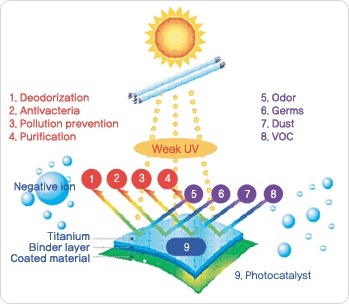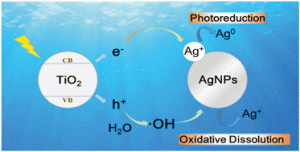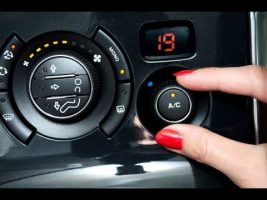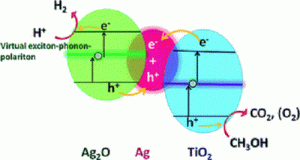Here Is A Publication On the WEB thats Shows the Use of Nano TiO2 in NASA
NASA develops a ‘black hole’ for stopping airborne cross-contamination

You’ve likely heard of the mysterious entities known as “black holes” – NASA as well as many scientists worldwide share a theory that black holes in space literally constitute holes in the observable universe from which nothing can ever escape. Any matter that encounters them will be pulled inward by their massive gravity, destroyed and lost to the universe forever.
Here on Earth and until recently, the black hole for destroying airborne cross-contamination in the food processing environment remained elusive using traditional technologies such as fiber filtration. “State of the art” HEPA-fiber filtration was developed for the America’s Nuclear Manhattan Project just before the end of WW II – and yes, some 66 years ago. Through the years, chemical applications and even toxic gases have been offered as solutions.
We all know and readily accept state-of-the-art sanitizers and disinfectants to clean our floors, filter air, treat processing equipment, wash hands, etc. Unfortunately, it is instinctive to disregard what we cannot see, touch, smell or hear; including the ever present flow of airborne cross-contamination of microorganisms and organics as they fall into our products and onto our cleaned surfaces.
The clear and present need within the food industry for a truly GREEN air sanitation solution – not relying on chemicals, random oxidants or filters – has finally been satisfied using a NASA-funded space technology. The technology is unique in providing no lower size limits, whereas former technologies such as HEPA are limited to measuring only particles that exceed 0.1 to 0.3 microns in size. There are no chemicals or toxic gases introduced, keeping operational costs low and protecting employee safety.
Technical Notes: How does it work?

Nano particle Titanium dioxide (TiO2) is the photocatalyst of choice. When TiO2 is irradiated with the UV photons surface bound hydroxyl radicals are formed. Surface bound hydroxyl radicals never become a gas like Ozone (O3). All the elements of the PCO reaction occur within its contained Reactor Bed. No byproducts are produced and no person exposed to adverse chemicals risks. The Photocatalytic reactor is self-cleaning by virtue of the reaction by-products (CO2 and water vapor generated by oxidized organic material on the catalyst surface).
Contrary to Ultraviolet (UV) photons that require extended microbe contact times to be an effective airborne killing device, this technology relies on collisions of microorganisms and organics with its surface bound hydroxyl radicals. Within this system, there can be as much as 177 Cubic Feet (ft.3) of active catalytic surface area that generates billions of hydroxyl radicals. These radicals are awaiting collision with microorganisms or organics that have been pulled into its reactor bed by its fan to be mineralized into CO2 and H2O vapor. Unclean air from the environment is transitioned through the reactor and is replaced with 99% clean air 24/7. This dilution effect drastically reduces microorganisms and organics from becoming airborne cross-contaminates.

An example of how is nano TiO2 being used in air purifying machines






